Current Projects
We study how different stressors affect honey bee and native bee pollinators. Below are some of the current projects ongoing in the lab. New projects are always in development!
GENOMICS AND ECO-EVOLUTION OF MULTI-SCALE SYMBIOSES (GEMS)
The Dolezal lab is excited to be part of the new NSF Biological Integration Institute GEMS, working primarily through the University of Illinois Institute of Genomic Biology, in collaboration with U. of Indiana and U. of Chicago.
See the press release about the institute here.
Through the GEMS institute, we will be working on new projects investigating microbial symbioses through focus on bee – clover interactions. U
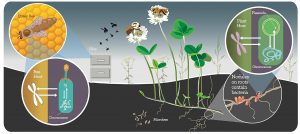
Understanding movement of microbes by small hive beetles (SHB; Aethina tumida) and developing methods for its control.
The small hive beetle, native to sub-Saharan Africa, has spread over the course of the past two decades as a result of intern
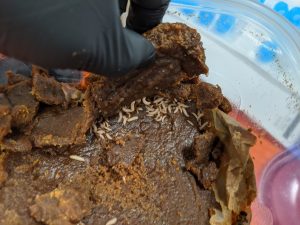
ational trade of honey bees and hive-related products. SHB is a parasite of social bee colonies, feeding primarily on pollen, honey and brood of honey bees, resulting in significant deleterious economic impact on the apiculture industry in North America. While often considered a secondary pest compared to Varroa mites, SHB pressure can cause the deaths of strong colonies within two weeks and can pose even greater problems for small colonies and apicultural storage facilities. SHB has been detected in all 48 contiguous U.S. states and Hawaii, with the most damage occurring in climates well-suited to SHB reproduction (e.g., Hawaii and the Southeastern states), though its range appears to be expanding and it will likely continue to do so with ongoing climate changes.
Illinois is on the front of this expansion, with heavy SHB pressure in the southern half of the state but very little incidence in Northern Illinois. In addition to attempting to monitor for movement through our Apiary Inspection project (detailed below), we are also interesting in better understanding how SHB moves pathogens between hives and developing tools for their control.
How do viruses impact honey bee behavior to affect pathogen transmission?
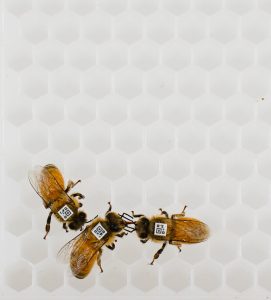
Honey bees provide critical pollination services, but multiple challenges to bee health have led to serious threats to agricultural pollination demands. One of the leading causes of colony death is viruses: honey bees are commonly infected with several devastating viruses, including Israeli acute paralysis virus (IAPV). Despite the importance of viruses to bee health, we lack an understanding of phenotypic effects of viruses on bees, their transmission, and thus how they actually cause colony failure.
In this integrative project, we seek to comprehensively investigate how honey bee viruses affect phenotypes at multiple levels: genomic, physiological, behavioral. Our research approach is guided by evolutionary biology—we are testing the hypothesis that there is a balancing act between adaptive host behavioral responses to reduce pathogen transmission and virus manipulation of bee physiology and behavior to increase their own transmission. To accomplish this, we combine behavioral observations with investigation of the gene expression, hormonal, and nutritional impacts of IAPV infection and evaluate how these mechanisms cause virus-induced shifts in behavior. The resulting, deeper understanding of how and why viruses affect bee phenotypes will contribute to the broad knowledge base needed to overcome challenges to bee health. This project is in collaboration with the Robinson, Brent, and Bonning laboratories, and was recently published in the Proceedings of the National Academy of Sciences. You can also hear about it on NPR’s Science Friday. Ongoing work attempts to tease apart the mechanisms and consequences of these effects.
Impact of prairie strips on reducing interacting stressors on pollinators
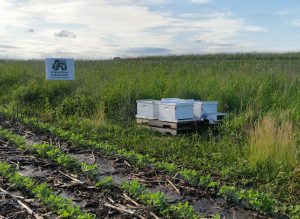
In collaboration with researchers at Iowa State University, we are part of an interdisciplinary teach studying how the implementation of Prairie Strips impacts pollinator health. This project involves testing how honey bees, native bees, and monarch butterflies are affected by native prairies planted within conventional corn and soybean agriculture in one of the most intensively managed and simplified agricultural systems in the world. These strips have been shown to have many benefits on water quality and erosion prevention and may also play an important role of providing habitat and nutrition to pollinators in an area where these resources are lacking.
With funding from the Foundation for Food and Agriculture Research (FFAR), we are combining field measurements of honey bee health and pollinator abundance (performed in Iowa) with laboratory experiments looking at how nutrition, pesticide exposure, and virus infection can interact to better tease out the relative importance of these stressors. This project is in collaboration with the Schulte-Moore, O’Neal, Toth, Bradbury, and Tyndall labs at Iowa State University.
How does landscape composition affect honey bee health and colony development?
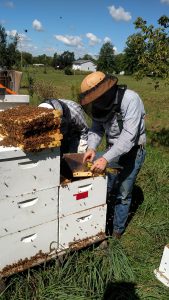
Ongoing work in collaboration with researchers at Iowa State University (Toth Lab, Soybean Entomology Labs), we have been studying how landscape composition in corn and soybean dominated agroecosystems affects honey bee colony growth and nutritional health, as well as native bee abundance and diversity. With funding from USDA, we have expanding this project to incorporate experimental study of how real-world field-level pest management affects pollinators and try to find solutions to the lack of bee nutritional resources in these landscapes. Work from this project was published in the Proceedings of the National Academy of Sciences, and continuing work in this system hopes to better understand the complex interactions affecting bees within corn and soybean agroecosystems.
How does juvenile stress affect adult resilience?
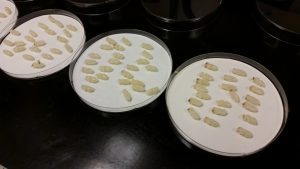
Honey bees and other pollinators are important to natural ecosystems and sustainable agriculture, but recent bee declines have been alarming. Increased disease exposure and poor nutrition due to decreasing plant diversity have been implicated as likely contributors to pollinator declines. These factors also appear to interact, as recent evidence shows that a low-diversity pollen diet increases disease susceptibility in adult honey bees. However, previous research has overlooked the importance of nutrition during the sensitive period of larval development. Nutritional stress on immatures can potentially have life-long and dire consequences on the health of adult workers, queens, and entire colonies. To date, it is unclear how nutritional deprivation during development affects disease resistance and immunocompetence at later stages.
To address this, we treat developing honey bees using two forms of field-relevant nutritional stress (‘chronic’ and ‘acute’) and test pathogen susceptibility and immune function in these bees as pupae and adults. The results of this work will help us better understand how the effects of poor nutrition during development is translated into health effects later in life, and will pave the way for more in-depth investigations of honey bee health and immunity.
Working with beekeepers to track and understand honey bee health across time and space
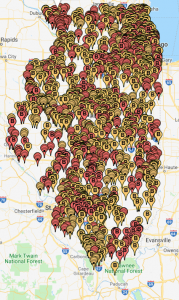
A major challenge to understanding widespread declines in honey bee health and productivity is access to large-scale datasets with which to investigate global trends. The main challenge to producing these datasets is often logistical. For researchers to manage and measure hives in large numbers across large areas is not feasible. In this project, we seek to combine ‘citizen scientists’ with already existing apiary inspection infrastructures to a) compile and analyze data already being collected and b) improve this data collection through addition of Varroa monitoring and hive growth estimates.
Currently, the inspectors from the Illinois Bees and Apiaries Program, inspect thousands of hives each year. By incorporating some extra data collection, and developing an analysis pipeline, we have the potential to build a database of location-specific information on >1000 hives per year over multiple years that can be used to understand global trends in bee health
We also provide the data collection protocol and instructions to beekeepers throughout the state and are working towards a streamlined format with which to report their data. By combining these approaches, we have the opportunity to build a large database of hive health through the year, with which we can analyze trends in hive growth and mite buildup related to landscape use, beekeeping practices, climatic gradients, etc as well as track the spread of mites and emergence and spread of new pests.